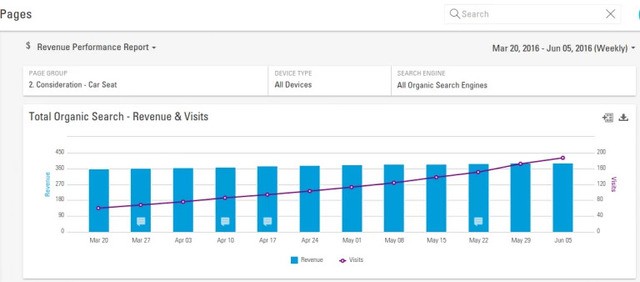For brands to see genuine success from their digital marketing strategies, they need to develop mature practices. They must grow from their early, rudimentary efforts that yield little success and become a highly efficient and effective content-production organization. Brands that reach these upper levels of maturation are able to scale their content production across their business, accurately measure their progress and results, and provide innate value to their customers. A recent survey of B2B businesses, however, found that only 8 percent viewed themselves as being at this late stage. Before looking at content audit, let's dive a little deeper into the survey results. More than half of the surveyed categorized themselves as being at the middle stages, described in the above survey as the adolescent and mature phases. These brands see some success and are beginning to delve into accurately measuring and integrating their processes across the organization. A correctly-run audit can provide brands with the positioning they need to progress further in marketing maturity and begin to build a content production system that will advance their organizations online. Here is how to take your content audit, and your business, to the next level.
What is a content audit?
A standard content audit is the process of categorizing the content you currently have to better understand your strengths and weaknesses. Armed with this information, you can then move forward and fill in any gaps, strengthening your online presence. The basic audit will follow these steps. 
1. Take an inventory of current content
You want to look at all the current content available on your website, including your main site, blog, and gated content. You need to have a complete list so you can accurately determine where any gaps in your content creation exist. You will also need to be checking for any duplicate content.
2. Evaluate if content is accurate and useful
Not only do you need to know what types of content you have available for users, but you also need to know if that content is accurate and useful. Content that needs to be updated because it now contains incorrect information, for example, should be addressed. You can provide visitors with better information by including links to updated posts. Develop a rating system that will be able to help you quickly gauge how important a piece of content is. Look for the value it offers users and how well it meets the guidelines you want to establish for your brand. Grade your content based on how much it needs to be updated. Feel free to test your knowledge with BrightEdge Digital Marketing Quiz or SEO Quiz.
3. Measure traffic and engagement rates for content
You also want to see how well your content is drawing traffic and if it is capturing the attention of your visitors. Note the types of content that seem to be resulting in the highest engagement rates. Look for patterns in styles and topics that can help you better understand the needs of your audience.
4. See how well the content is organized on the site
Successful content marketing also requires taking a careful look at how your material is organized on the site. Customers and Google alike want to see sites that they can easily navigate to find what they seek. This means making URLs easy to understand, labeling features on the page clearly, including inbound links that are useful, and making it simple for people to return to the homepage.
5. Check the optimization of the content and see where weaknesses lie
Have a checklist prepared of optimization features that you want for every page of your content. This should include the basics such as:
- The keyword in your H1 and H2 tags
- Alt tags
- The keyword in your URL
- An engaging, customized meta description
- Internal links to relevant pages
 Any pages missing these features should be edited to help them rank higher.
Any pages missing these features should be edited to help them rank higher.
6. Determine what content is missing
Once you know exactly what content you have published and how well it is helping you to meet your business objectives, you then need to determine which gaps you should fill. Look for trends in your content-- such as blog posts that are missing images or posting multiple pieces related to your product and fewer pieces pertaining to the top of the sales funnel.
Taking your content audit to the next level of marketing maturity
Although this basic content audit can be helpful for your marketing efforts, those who want to mature in their content marketing strategy can also use this opportunity to amplify their efforts and start to see improved results.
1 Map all your content to the buyer’s journey for specific personas.
For you to mature in online marketing, you need to know exactly who you are addressing and what they want to see from your brand. You do this by understanding your targeted customers’ pain points and concerns. You also understand where they are on the path towards a purchase and the type of information they need to encourage them to move forward. Once you have this information, you can align your current content to this path and gain a clearer picture of what you need to produce and where you need to focus your efforts to better move people towards conversion. You will also be able to produce more effective calls to action.
2. Use more in-depth metrics.
The more information you can gain concerning the impact of your content, the better you will be able to develop an effective and scalable strategy. Look at statistics related to your backlink profile for the pieces of content, noting the topics and styles that seem to attract the most high-quality attention. Measure the impact of different pages and funnels on sales and conversions. For example, on the BrightEdge platform, you can create groups for different types of pages, such as those related to specific topics or those targeting specific customers, and then monitor those groups compared to sales and conversion data. You can also watch month-over-month and year-over-year data to see the impact of your efforts to improve the success of your pages.

3. Make sure your content efforts stretch across specialty and departmental boundaries.
One of the focal points of the marketing maturity model is making sure that your content development efforts become integrated across the organization. This means that content should play a role in a variety of business functions, including customer service and PR. Monitor how much content has been developed to fill these roles and how well they are helping to improve the customer experience and the brand reputation. You also want to check how well your marketing efforts stretch across the different specialties within the marketing department. Your content experts, SEO specialists, paid search professionals, and social media contributors should all be collaborating on the creation of effective content and means of distribution for specific pieces. A content audit can be an effective, helpful means of boosting your content marketing effectiveness and providing the lift your entire organization needs to mature in their marketing efforts. Take this opportunity to go beyond the minimum and instead enhance your content production effectiveness and efficiency by becoming a more integrated, data-driven, and content-oriented organization.


